Cite this document
(Pharmacokinetics and Therapeutics of Drugs Lab Report Example | Topics and Well Written Essays - 1000 words, n.d.)
Pharmacokinetics and Therapeutics of Drugs Lab Report Example | Topics and Well Written Essays - 1000 words. https://studentshare.org/health-sciences-medicine/1743466-pharmacokinetics-and-therapeutic
Pharmacokinetics and Therapeutics of Drugs Lab Report Example | Topics and Well Written Essays - 1000 words. https://studentshare.org/health-sciences-medicine/1743466-pharmacokinetics-and-therapeutic
(Pharmacokinetics and Therapeutics of Drugs Lab Report Example | Topics and Well Written Essays - 1000 Words)
Pharmacokinetics and Therapeutics of Drugs Lab Report Example | Topics and Well Written Essays - 1000 Words. https://studentshare.org/health-sciences-medicine/1743466-pharmacokinetics-and-therapeutic.
Pharmacokinetics and Therapeutics of Drugs Lab Report Example | Topics and Well Written Essays - 1000 Words. https://studentshare.org/health-sciences-medicine/1743466-pharmacokinetics-and-therapeutic.
“Pharmacokinetics and Therapeutics of Drugs Lab Report Example | Topics and Well Written Essays - 1000 Words”. https://studentshare.org/health-sciences-medicine/1743466-pharmacokinetics-and-therapeutic.


